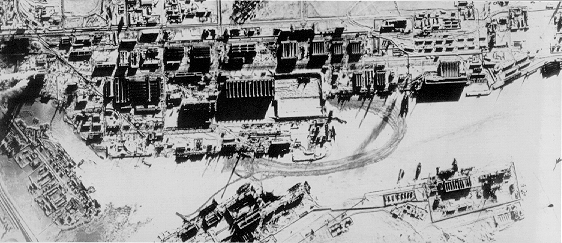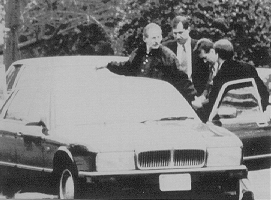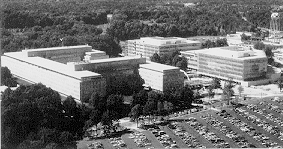U.S. ESPIONAGE AND INTELLIGENCE

Organization, Operations, and Management, 1947-1996

 In the aftermath of World War II, with the Cold War looming on the horizon, the United States
began the process of developing an elaborate peacetime intelligence structure that would extend
across a number of government departments. The operations of the U.S. intelligence community
during the Cold War would range from running single agents, to marshaling the talents of thousands
to build and deploy elaborate spy satellites.
In the aftermath of World War II, with the Cold War looming on the horizon, the United States
began the process of developing an elaborate peacetime intelligence structure that would extend
across a number of government departments. The operations of the U.S. intelligence community
during the Cold War would range from running single agents, to marshaling the talents of thousands
to build and deploy elaborate spy satellites.The end of the Cold War brought major changes, but not the end of the U.S. government's requirement for an elaborate intelligence structure. A number of intelligence organizations have been consolidated or altogether eliminated. New organizations have been established to provide more coherent management of activities ranging from military espionage, to imagery collection, to the procurement of airborne intelligence systems. The end of the Cold War has brought about the declassification of much information about intelligence organization and espionage activities that took place prior to the collapse of the Soviet Union.
Sample Document 2: Charter of the National Reconnaissance Office, March 27, 1964.
Sample Document 3: History of Navy HUMINT: Annual History for Task Force 157, a classified U.S. Navy intelligence unit, 1974.
 U.S. Espionage and Intelligence: Organization, Operations, and Management, 1947-1996
publishes together for the first time recent unclassified and newly declassified documents pertaining
to the organizational structure, operations, and management of the U.S. intelligence community over
the last fifty years, cross-indexed for maximum accessibility. This set reproduces on microfiche
1,174 organizational histories, memoranda, manuals, regulations, directives, reports, and studies,
representing over 36,102 pages of documents from the Office of the Director of Central Intelligence,
the Central Intelligence Agency, National Reconnaissance Office, National Security Agency,
Defense Intelligence Agency, military service intelligence organizations, National Security Council
and other organizations.
U.S. Espionage and Intelligence: Organization, Operations, and Management, 1947-1996
publishes together for the first time recent unclassified and newly declassified documents pertaining
to the organizational structure, operations, and management of the U.S. intelligence community over
the last fifty years, cross-indexed for maximum accessibility. This set reproduces on microfiche
1,174 organizational histories, memoranda, manuals, regulations, directives, reports, and studies,
representing over 36,102 pages of documents from the Office of the Director of Central Intelligence,
the Central Intelligence Agency, National Reconnaissance Office, National Security Agency,
Defense Intelligence Agency, military service intelligence organizations, National Security Council
and other organizations.U.S. Espionage and Intelligence presents a unique look into the internal workings of America's intelligence community. The documents gathered here shed further light on U.S. intelligence organization and activities during the Cold War, and describe the consolidation and reevaluation of the intelligence community in the post-Cold War era. They are drawn from diverse sources, including the National Archives, manuscript collections in the Library of Congress, court files of major espionage prosecutions, presidential libraries, and most importantly, Freedom of Information Act requests. The result of this effort is an authoritative documents publication which, together with the National Security Archive's previous collection on the structure and operations of the U.S. intelligence community, The U.S. Intelligence Community: 1947-1989, published in early 1990, provides a comprehensive record of U.S. espionage and intelligence activities since World War II.
U.S. Espionage and Intelligence provides a wealth of information and documentation on key aspects of intelligence organization and operations during and after the Cold War, including such extraordinary topics as:
Significance of the Collection
The U.S. intelligence community has played a key role in advising presidents from Harry
Truman to Bill Clinton on the intentions and activities of the Soviet Union, as well as of other
nations. It also came to absorb a significant portion of the federal budget, reaching an approximate
high of $30 billion in the late 1980s.
U.S. Espionage and Intelligence allows scholars direct access to the newly declassified, detailed primary documents that contain the history of the military, diplomatic, and intelligence components of the Cold War, and which go far beyond what is available in secondary sources. This new information is essential for reaching an accurate understanding of what was happening behind the scenes and how it related to the more public aspects of Cold War policy and operations.
The material contained in this set concerning the post-Cold War era is crucial in assessing the intelligence community's performance in critical areas such as the Persian Gulf War and the Aldrich Ames case. The material is also vital in understanding the evolution of the intelligence community since the end of the Cold War and its possible future--for that evolution may significantly influence the ability of the intelligence community to deal with critical threats such as proliferation of weapons of mass destruction and terrorism.
Through U.S. Espionage and Intelligence the researcher gains access to a wide variety of documents: internal histories of the CIA and a variety of military intelligence organizations; program histories of the SR-71 and CORONA; director of central intelligence and Department of Defense directives establishing organizations such as the National Reconnaissance Office and the National Imagery and Mapping Agency; plans for the consolidation and reform of Defense intelligence organizations after the Cold War and memoranda implementing the reforms; and assessments of intelligence community performance in a number of areas.
The Guide includes an essay, events chronology, glossaries of key individuals, organizations, and terms, document catalog, and a bibliography of secondary sources.
03/27/64 Directive 5105.23, National Reconnaissance Office, Department of Defense, Top Secret Directive 05/23/67 Report on Plots to Assassinate Fidel Castro, Central Intelligence Agency, Secret Memorandum
07/00/73 Allen Welsh Dulles as Director of Central Intelligence, 26 February 1953-29 November 1961, Central Intelligence Agency, Top Secret Biographic Sketch
00/00/82 History of the Navy HUMINT Program, United States Navy, Top Secret History
03/15/91 Plan for Restructuring Defense Intelligence, Assistant Secretary of Defense for Command, Control, and Communication Intelligence, Secret Report
01/06/92 Task Force Report on Greater CIA Openness, Director of Central Intelligence, [Classification Excised] Memorandum
06/01/92 DCID 2/9, Management of National Imagery Intelligence, Director of Central Intelligence, Secret Intelligence Directive
09/00/92 Appendixes A, B, and C to the Final Report: National Reconnaissance Program Task Force for the Director of Central Intelligence, National Reconnaissance Program Task Force, Secret Report
12/18/92 Directive 5200.37, Centralized Management of Department of Defense Human Intelligence (HUMINT) Operations, Department of Defense, [Classification Unknown] Directive
08/00/93 Intelligence Successes and Failures in Operations Desert Shield/Storm, House Committee on Armed Services, [Classification Unknown] Report
01/21/94 A Description of Procedures and Findings Related to the Report of the U.S. Environmental Task Force, King Publishing, Paper
12/07/95 Statement of the Director of Central Intelligence on the Clandestine Services and the Damage Caused by Aldrich Ames, Director of Central Intelligence, Statement
03/01/96 Preparing for the 21st Century: An Appraisal of U.S. Intelligence, Commission on the Roles and Capabilities of the United States Intelligence Community, Report
12/19/96 United States of America v. Harold J. Nicholson, Superseding Indictment, U.S. District Court, Eastern District of Virginia, Indictment
Content
Reproduces on microfiche 1,174 U.S. government records totaling 36,102 pages of
documentation concerning the organizational structure, operations, and management of the
intelligence community from World War II to the present.
Materials were identified, obtained, assembled, and indexed by the National Security Archive.
Series
The Special Collections
Arrangement
Microfiche are arranged chronologically. For ease of use, each document bears a unique
accession number to which all indexing is keyed.
Standards
The documents are reproduced on 35mm silver halide archivally permanent positive microfiche conforming to NMA and
BSI standards.
Any microfiche found to be physically substandard in any way will be replaced free of charge.
Indexing
A printed Guide and Index accompanies the microfiche collection. The Guide contains
an events chronology, glossaries, chronological document catalog and a bibliography of secondary sources.
The Index provides in-depth, document level access to subjects and individuals.
Date of Publication
April 1997
Contact Chadwyck-Healey, Inc. for orders and inquiries (click here).
Loch Johnson, Department of Political Science, University of Georgia author, Secret Agencies: U.S. Intelligence in a Hostile World
David Wise, author, Nightmover: How Aldrich Ames Sold the CIA to the KGB for $4.6 Million
Praise for U.S. Espionage and Intelligence, 1947-1996
"Serious students of the structure and operations of American intelligence rely on the work of the
National Security Archive. The new collection of intelligence documents, compiled for the
Archive by Jeffrey T. Richelson, helps to pierce the labyrinth."
David Wise
Author of Nightmover: How Aldrich Ames Sold the CIA to the KGB for $4.6 Million
"An invaluable supplement to the National Security Archive's previous collection, The U.S. Intelligence Community 1947-1989, this brings the most recently declassified documents to the reader. Jeffrey Richelson's useful introduction also serves to detail changes that have occurred in the structure of the U.S. espionage establishment."
John Prados
Author of Presidents' Secret Wars